Optimization of lipid extraction from Khai-Nam (Wolffia sp.) by ultrasound-assisted extraction using response surface methodology
Keywords:
Lipid extraction, Khai-Nam, Ultrasound, Response surface methodologyAbstract
The objective of this research was to investigate the optimal condition of lipid extraction from Khai-Nam (Wolffia sp.) by ultrasound-assisted extraction (UAE) using response surface methodology (RSM) with Box-Behnken design (BBD). The factors in this work including solid to solvent ratio (0.1:10-1:10 g/mL), extraction time (10-30 min) and sonication power (78-130 Watt). The experimental results showed that these three factors affected yield of lipid extraction. The optimum conditions for lipid extraction were solid to solvent ratio of 0.1:10 g/mL, extraction time of 30 min and sonication power of 130 Watt, which resulted in lipid yield of 9.78%. After the experiments performed under these conditions, the maximum lipid yield was found 9.54 ± 0.31%, which is similar to the prediction value. Therefore, it can be concluded that the regression model obtained from the experimental data could be applied for accurate prediction of the lipid yield obtained by UAE.
References
Sangyoka S, Kusolma P, Suthiphasilp R. The potential of Wolffia globosa and Cladophora sp. treated the wastewater and lipid production. PSRU Journal of Science and Technology. 2016;1(1):40-52.
Tipnee S, Jutiviboonsuk A, Wongtrakul P. The bioactivity study of active compounds in Wolffia globosa extract for an alternative source of bioactive substances. Cosmetics. 2017; 4(4):53.
Appenroth K, Sree K, Böhm V, Hammann S, Vetter W, Leiterer M et al. Nutritional value of duckweeds (Lemnaceae) as human food. Food Chem. 2017;217:266-273.
Appenroth K, Sree K, Bog M, Ecker J, Seeliger C, Böhm V, et al. Nutritional value of the duckweed species of the genus Wolffia (Lemnaceae) as human food. Front Chem. 2018;6:1-15.
Ruekaewma N, Piyatiratitivorakul S, Powtongsook S. Culture system for Wolffia globosa L. (Lemnaceae) for hygiene human food. Songklanakarin J Sci Technol. 2015;37:575-580.
Kansinee P, Sukhoom R. Proceedings of 47th Kasetsart University Annual Conference: Fisheries. In: Experimental study on culture of wolffia (Wolffia arrhiza (L.) Wimm.) and it's use for gold fish color quality improvement. Bangkok (Thailand): The Thailand Research Fund, Bangkok (Thailand). 2009:641.
Xie W, Huang Q, Li G, Rensing C, Zhu Y. Cadmium accumulation in the rootless macrophyte Wolffia globosa and its potential for phytoremediation. Int J Phytoremediation. 2013;15(4):385-397.
Marhamati M, Kheirati Kakhaki Z, Rezaie M. Advance in ultrasound-assisted extraction of edible oils: a review. J Nutr Fast Health. 2020; 8(4): 220-230.
Bezerra MA, Santelli RE, Oliveira EP, Villar LS, Escaleira LA. Response surface methodology (RSM) as a tool for optimization in analytical chemistry. Talanta. 2008;76:965-977.
Kantakapan K, Sukpondma Y. Optimization of total phenolics and flavonoids from ginger using response surface methodology. HCU J Health Sci. 2016;39(20):69-80.
Byreddy AR, Gupta A, Barrow CJ, Puri M. Comparison of cell disruption methods for improving lipid extraction from thraustochytrid strains. Mar drugs. 2015;13(8):5111-5127.
Zhang X, Ya S, Tyagi RD, Drogui P, Surampalli RY. Ultrasonication assisted lipid extraction from oleaginous microorganisms. Bioresour Technol. 2014;158:253-261.
Chanpirak A, Dumnin P, Hongpuay A. Optimization of oil extraction from spent coffee grounds (Coffea canephora var.robusta/Coffea arabica) by hexane using response surface methodology. J KMUTNB. 2018;28(4):799-811.
Awapak D, Mahae N, Pitchairat D. Optimization of polysaccharide extraction from Gracilaria fisheri using response surface methodology. KKU Sci J. 2013;41(2):414-30.
Katsuwan P, Banjong K. Optimization of microwave-assisted extraction of Papaya seed oil by response surface methodology. SWU J Sci Technol. 2018;10(20):76-88.
Xu G, Liang C, Huang P, Liu Q, Xu Y, Ding C, Li T. Optimization of rice lipid production from ultrasound-assisted extraction by response surface methodology. J Cereal Sci. 2016;70:23-28.
Hadrich B, Akremi I, Dammak M, Barkallah M, Fendri I, Abdelkafi S. Optimization of lipids’ ultrasonic extraction and production from Chlorella sp. using response-surface methodology. Lipids Health Dis. 2018;17:87.
Baidy, S, Patel AB. Effect of Co-cultivation of Wolffia arrhiza (L.) on flesh quality and organoleptic quality of Catla, Rohu, Mrigal, Grass carp, Puntius and Amur carp. Int J Fish Aquatic Stud. 2017;5(5):327-333.
Worapun I, Chooppava C, Thinvongpituk C. Optimal conditions of friction welding process for AISI 1015 steel using response surface methodology. KKU Res J. 2013;18(6):909-924.
Zahan KA, Kano M. Biodiesel production from palm oil, its by-products, and mill effluent: a review. Energies. 2018;11(8),2132:1-25.

Downloads
Published
How to Cite
Issue
Section
License
Copyright (c) 2021 Naresuan Phayao Journal

This work is licensed under a Creative Commons Attribution-NonCommercial-NoDerivatives 4.0 International License.
ผู้นิพนธ์ต้องรับผิดชอบข้อความในบทนิพนธ์ของตน มหาวิทยาลัยพะเยาไม่จำเป็นต้องเห็นด้วยกับบทความที่ตีพิมพ์เสมอไป ผู้สนใจสามารถคัดลอก และนำไปใช้ได้ แต่จะต้องขออนุมัติเจ้าของ และได้รับการอนุมัติเป็นลายลักษณ์อักษรก่อน พร้อมกับมีการอ้างอิงและกล่าวคำขอบคุณให้ถูกต้องด้วย
The authors are themselves responsible for their contents. Signed articles may not always reflect the opinion of University of Phayao. The articles can be reproduced and reprinted, provided that permission is given by the authors and acknowledgement must be given.







